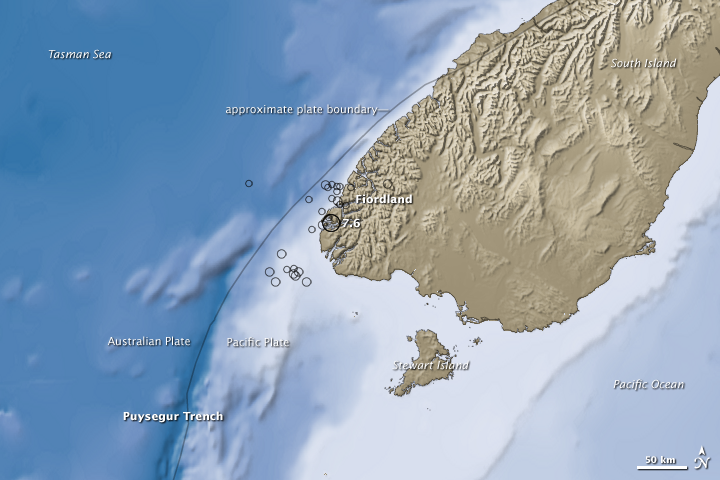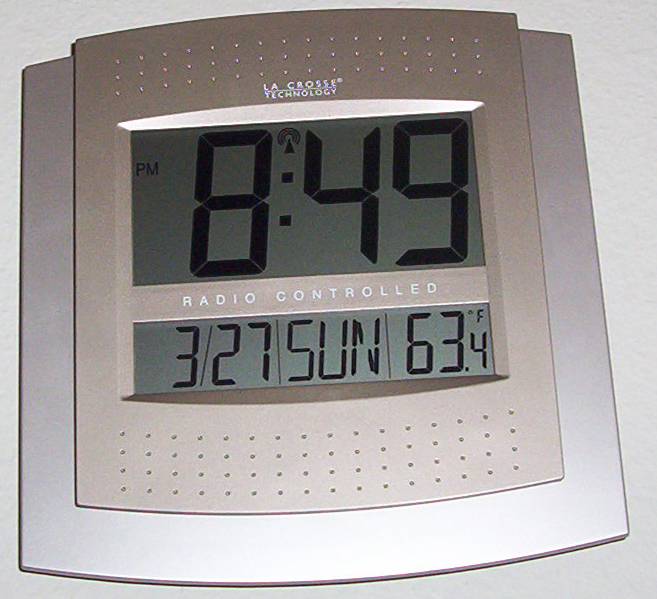|
2009 Dusky Sound Earthquake
The 2009 Dusky Sound earthquake was a 7.8 earthquake that struck a remote region of Fiordland, New Zealand, on 15 July at 21:22 local time (09:22 UTC). It had an initially–reported depth of , and an epicentre near Dusky Sound in Fiordland National Park, which is north-west of Invercargill. It was the country's largest earthquake magnitude since the 1931 Hawke's Bay earthquake, but caused only minor damage and there were no casualties. A tsunami accompanied the event and had a maximum measured run-up of . Earthquake New Zealand's Institute of Geological and Nuclear Sciences (GNS Science) initially measured the earthquake at 6.6. The United States Geological Survey's preliminary measurement was 8.0 before it was revised to 7.8. It was New Zealand's biggest earthquake magnitude since the 1931 Hawke's Bay earthquake, and equal in magnitude to the 2016 Kaikōura earthquake. The 2009 earthquake occurred after a sequence of seismic events in northern Fiordland since 1988—six ... [...More Info...] [...Related Items...] OR: [Wikipedia] [Google] [Baidu] |
Time In New Zealand
Time in New Zealand is divided by law into two standard time, standard time zones. The main islands use New Zealand Standard Time (NZST), 12 hours in advance of Coordinated Universal Time (UTC) / Military time zone, military M (Mike), while the outlying Chatham Islands use Chatham Standard Time Zone, Chatham Standard Time (CHAST), 12 hours 45 minutes in advance of UTC / military M^ (Mike-Three). During summer months – from the last Sunday in September until the first Sunday in April – daylight saving time is observed and clocks are advanced one hour. New Zealand Daylight Time (NZDT) is 13 hours ahead of UTC, and Chatham Daylight Time (CHADT) 13 hours 45 minutes ahead. New Zealand's associated states – the Cook Islands and Niue – and the dependent territory of Tokelau use several different time zones at their own discretion. History On 2 November 1868, New Zealand officially adopted a standard time to be observed nationally, and was the first country to do so, abou ... [...More Info...] [...Related Items...] OR: [Wikipedia] [Google] [Baidu] |
2003 Fiordland Earthquake
The 2003 Fiordland earthquake struck the remote region of Fiordland in the South Island of New Zealand on 22 August 2003, at 12:12 am NZST. The epicentre was deep, and was thought to be near Secretary Island at the entrance to Doubtful Sound. At 7.2 magnitude, it was one of the largest quakes in the country for some time, and was the largest shallow quake since the 1968 Inangahua earthquake. There was an aftershock two hours later at 2:12 am, followed over several days by frequent small tremors; two months after the earthquake, there had been 8,000 aftershocks. Fiordland is one of the seismically active parts of the country according to GNS seismologist Dr. Warwick Smith, as they are a relief mechanism for stresses as the Australian and Pacific tectonic plates are being forced together in the area, with the Pacific plate subducting under the Australian plate. In August 2004, there was another large earthquake of magnitude 7.1 in Fiordland. This was the same location as an ea ... [...More Info...] [...Related Items...] OR: [Wikipedia] [Google] [Baidu] |
Strong Ground Motion
In seismology, strong ground motion is the strong earthquake shaking that occurs close to (less than about 50 km from) a causative fault. The strength of the shaking involved in strong ground motion usually overwhelms a seismometer, forcing the use of accelerographs (or strong ground motion accelerometers) for recording. The science of strong ground motion also deals with the variations of fault rupture, both in total displacement, energy released, and rupture velocity. As seismic instruments (and accelerometers in particular) become more common, it becomes necessary to correlate expected damage with instrument-readings. The old Modified Mercalli intensity scale (MM), a relic of the pre-instrument days, remains useful in the sense that each intensity-level provides an observable difference in seismic damage. After many years of trying every possible manipulation of accelerometer-time histories, it turns out that the extremely simple peak ground velocity (PGV) provides t ... [...More Info...] [...Related Items...] OR: [Wikipedia] [Google] [Baidu] |
Earthquake Rupture
In seismology, an earthquake rupture is the extent of slip that occurs during an earthquake in the Earth's crust. Earthquakes occur for many reasons that include: landslides, movement of magma in a volcano, the formation of a new fault, or, most commonly of all, a slip on an existing fault. Nucleation A tectonic earthquake begins by an initial rupture at a point on the fault surface, a process known as nucleation. The scale of the nucleation zone is uncertain, with some evidence, such as the rupture dimensions of the smallest earthquakes, suggesting that it is smaller than 100 m while other evidence, such as a slow component revealed by low-frequency spectra of some earthquakes, suggest that it is larger. The possibility that the nucleation involves some sort of preparation process is supported by the observation that about 40% of earthquakes are preceded by foreshocks. However, some large earthquakes, such as the M8.6 1950 India – China earthquake., have no foreshocks and it ... [...More Info...] [...Related Items...] OR: [Wikipedia] [Google] [Baidu] |
Strike-slip Tectonics
Strike-slip tectonics or wrench tectonics is a type of tectonics that is dominated by lateral (horizontal) movements within the Earth's crust (and lithosphere). Where a zone of strike-slip tectonics forms the boundary between two tectonic plates, this is known as a transform or conservative plate boundary. Areas of strike-slip tectonics are characterised by particular deformation styles including: ''stepovers'', ''Riedel shears'', ''flower structures'' and ''strike-slip duplexes''. Where the displacement along a zone of strike-slip deviates from parallelism with the zone itself, the style becomes either transpressional or transtensional depending on the sense of deviation. Strike-slip tectonics is characteristic of several geological environments, including oceanic and continental transform faults, zones of oblique collision and the deforming foreland of zones of continental collision. Deformation styles Stepovers When strike-slip fault zones develop, they typically form as sev ... [...More Info...] [...Related Items...] OR: [Wikipedia] [Google] [Baidu] |
Puysegur Trench
The deep Puysegur Trench is a deep cleft in the floor of the south Tasman Sea formed by the subduction of the Indo-Australian Plate under the Pacific Plate to the south of New Zealand. Immediately to its east lies the Puysegur Ridge, a northern extension of the Macquarie Ridge, which separates the Puysegur Trench from the Solander Trough. To the west is the expanse of the Tasman Basin, which stretches most of the distance to Australia. To the north of the trench lies the Fiordland Basin, which can be considered an extension of the trench. The Puysegur Trench mirrors the Kermadec Trench and Tonga Trench north of New Zealand. The Puysegur Trench stretches for over 800 kilometres south from the southwesternmost point of the South Island's coast, its southernmost extent being 400 kilometres due west of the Auckland Islands. It is named after Puysegur Point. Tectonic relationships The Australian Plate is subducting under the Pacific Plate at a rate of /year at the Puyseg ... [...More Info...] [...Related Items...] OR: [Wikipedia] [Google] [Baidu] |
Oblique Subduction
Oblique subduction is a form of subduction (i.e. a tectonic process involving the convergence of two Tectonic plate, plates where the denser plate descends into Earth's interior) for which the convergence direction differs from 90° to the plate boundary. Most Convergent boundary, convergent boundaries involve oblique subduction, particularly in the Ring of Fire including the Ryukyu Trench, Ryukyu, Aleutian Trench, Aleutian, Middle America Trench, Central America and Peru–Chile Trench, Chile subduction zones. In general, the obliquity angle is between 15° and 30°. Subduction zones with high obliquity angles include Sunda Trench, Sunda trench (ca. 60°) and Ryukyu arc (ca. 50°). Obliquity in plate convergence causes differences in Strike and dip, dipping angle and subduction velocity along the plate boundary. Tectonic processes including Slab rollback, slab roll-back, trench retreat (i.e. a tectonic response to the process of slab roll-back that moves the Oceanic trench, trench ... [...More Info...] [...Related Items...] OR: [Wikipedia] [Google] [Baidu] |
Subduction
Subduction is a geological process in which the oceanic lithosphere and some continental lithosphere is recycled into the Earth's mantle at the convergent boundaries between tectonic plates. Where one tectonic plate converges with a second plate, the heavier plate dives beneath the other and sinks into the mantle. A region where this process occurs is known as a subduction zone, and its surface expression is known as an arc-trench complex. The process of subduction has created most of the Earth's continental crust. Rates of subduction are typically measured in centimeters per year, with rates of convergence as high as 11 cm/year. Subduction is possible because the cold and rigid oceanic lithosphere is slightly denser than the underlying asthenosphere, the hot, ductile layer in the upper mantle. Once initiated, stable subduction is driven mostly by the negative buoyancy of the dense subducting lithosphere. The down-going slab sinks into the mantle largely under its own ... [...More Info...] [...Related Items...] OR: [Wikipedia] [Google] [Baidu] |
Reverse Fault
In geology, a fault is a planar fracture or discontinuity in a volume of rock across which there has been significant displacement as a result of rock-mass movements. Large faults within Earth's crust result from the action of plate tectonic forces, with the largest forming the boundaries between the plates, such as the megathrust faults of subduction zones or transform faults. Energy release associated with rapid movement on active faults is the cause of most earthquakes. Faults may also displace slowly, by aseismic creep. A ''fault plane'' is the plane that represents the fracture surface of a fault. A ''fault trace'' or ''fault line'' is a place where the fault can be seen or mapped on the surface. A fault trace is also the line commonly plotted on geological maps to represent a fault. A ''fault zone'' is a cluster of parallel faults. However, the term is also used for the zone of crushed rock along a single fault. Prolonged motion along closely spaced faults can blur the ... [...More Info...] [...Related Items...] OR: [Wikipedia] [Google] [Baidu] |





